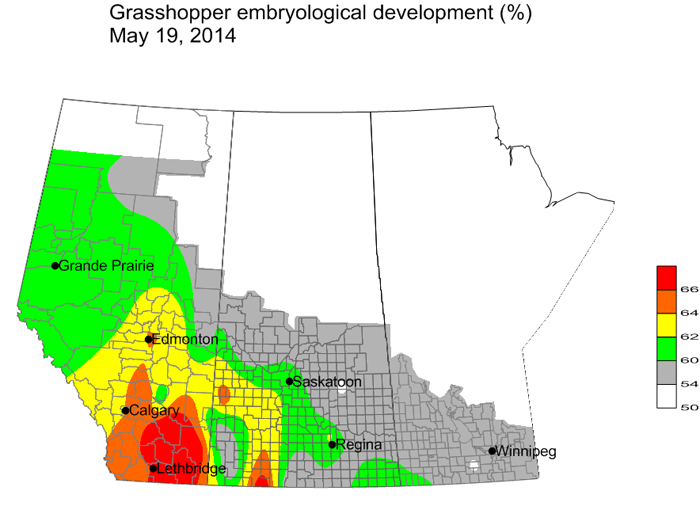Manitoba Insect and Disease Update: May 21, 2014
Compiled by:
- John Gavloski, Entomologist
Manitoba Agriculture, Food and Rural Development
Phone: (204) 745-5668
Fax: (204) 745-5690. - Vikram Bisht, Plant Pathologist
Manitoba Agriculture, Food and Rural Development
Phone: (204) 745-0260
Fax: (204) 745-5690
To report observations on insects or plant pathogens that may be of interest or importance to farmers and agronomists in Manitoba, please send messages to the above contact address.
To be placed on an E-mail list so you will be notified immediately when new Manitoba Insect and Disease Updates are posted, please contact John Gavloski at the address or numbers listed above.
Summary
Insect and disease activity continues to be low on crops in Manitoba. The cool temperature has slowed the emergence of many insects. There is no evidence to date of any major movement of insects that get blown into Manitoba form the southern U.S., such as diamondback moth and aster leafhopper.
Grasshoppers: When will emergence likely start
The species of grasshoppers that can be pests of crops all overwinter as eggs. Degree day models can be used to forecast anticipated dates of emergence for these pest species. Based on such models it will likely be early-June before we see a start to the emergence of these species of grasshoppers in most areas.

The map for the embryological development of grasshopper eggs considers the temperatures in late-summer / early-fall, and the temperatures in the spring. Development is calculated from heat units accumulated above 10C (Gage et al. 1976. The Canadian Entomologist: 245-253). The model to produce the maps was developed for 3 of the pest species of grasshoppers. So far eggs of our pest species of grasshoppers are less than 60% developed for most of Manitoba.
Note that there are a few non-pest species of grasshoppers that overwinter as partially developed nymphs. Any larger grasshoppers you may see this May will be of these non-pest species. The map above does not apply to these species. Some examples of these early-season non-pest species of grasshoppers include the brown-spotted grasshopper (Psoloessa delicatula), which overwinters as 4th or 5th instar nymphs. It is an important food item for the survival of the nestlings of grassland songbirds, and would be more common in western than eastern Manitoba. The specklewinged grasshopper (Arphia conspersa) overwinters as 5th instar nymphs, and is another grasshopper that may be seen in a more advanced stage early in the season. There is also a species called the club-horned grasshopper (Aeropedellus clavatus) that can confuse those keeping an eye on the grasshopper hatch. The club-horned grasshopper overwinters as an egg, but hatches more than a month earlier than pest species. The pasture grasshopper (Melanoplus confusus) is also a species that hatches very early, hatching in early spring. None of these species will be at levels that could be damaging to crops.
Recent Rain and Grasshoppers
The recent rains will likely do very little to negatively impact the survival of our pest species of grasshoppers. These species are currently eggs in the soil, and the eggs have a coating that makes them quite resilient to excess moisture. It is once the eggs hatch, which this year will likely start in early-June, that excess moisture can significantly reduce grasshopper numbers.

Figure 1. Grasshopper Eggs
Insect Monitoring Programs
Diamondback Moth: So far, from 74 traps that have been placed across Manitoba to monitor activity of adult diamondback moths, there have been a total of 14 diamondback moths caught. The highest counts so far are 3 from a trap near Elma, and 2 from a trap near Miniota. So counts have been very low through early and mid-May. There is currently no indication of any mass movements of diamondback moth, or other crop feeding insects, into Manitoba from southern areas.
Wireworms and Cutworms Needed. A reminder that wireworms and cutworms are needed for research on the regional species distribution of wireworms in Manitoba, and parasitoids of cutworms. So if you find any noticeable populations of these insects, please let us know. See last weeks update for details on how to collect and send samples.

